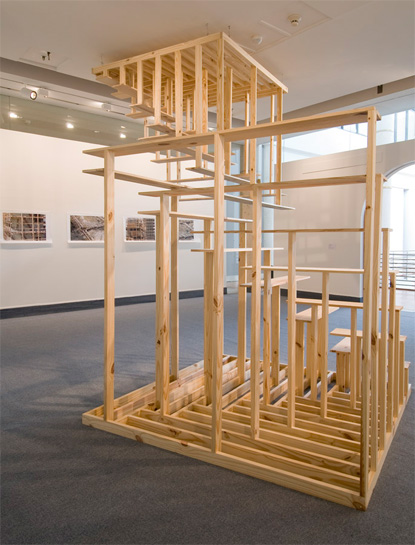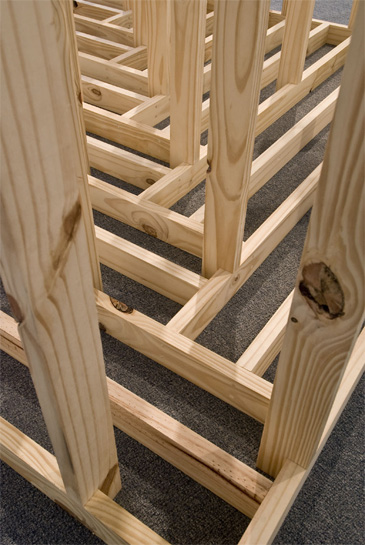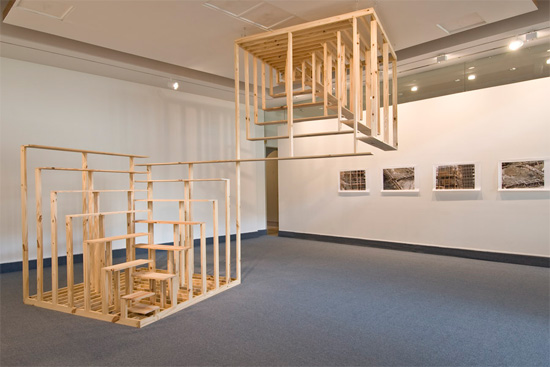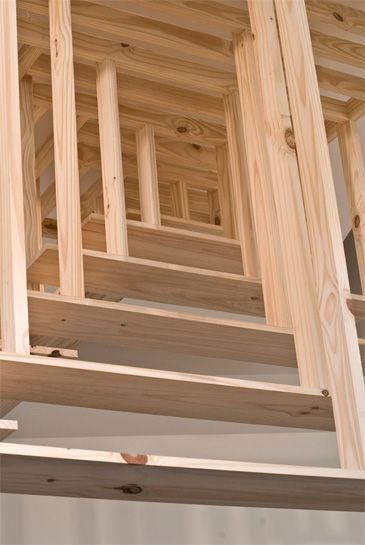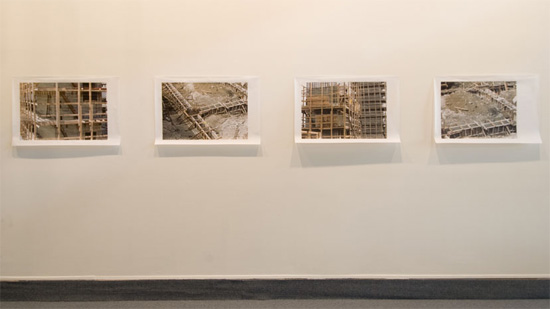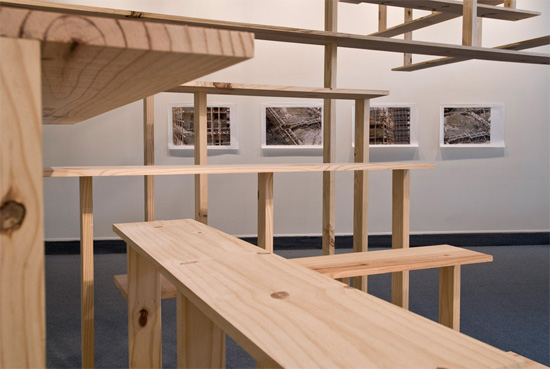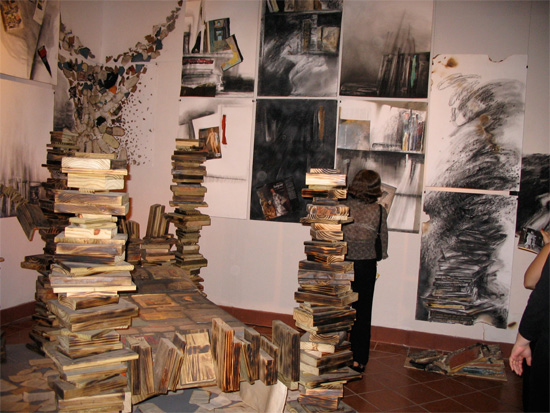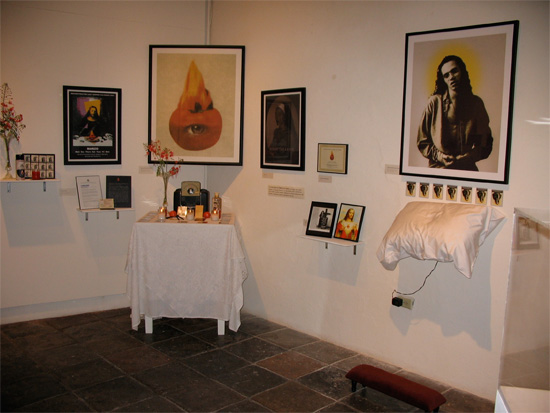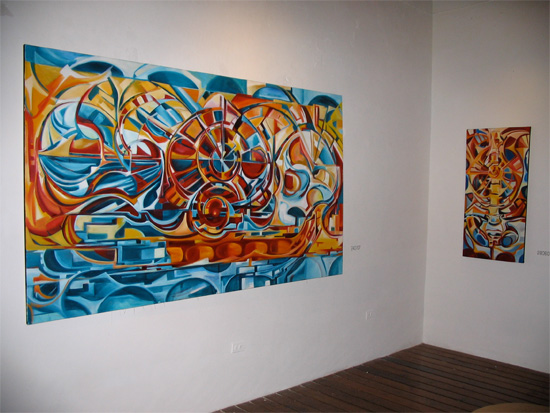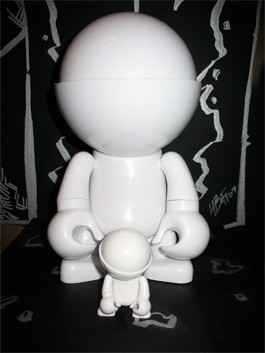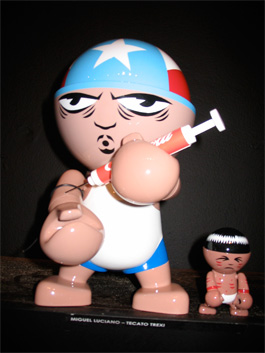|
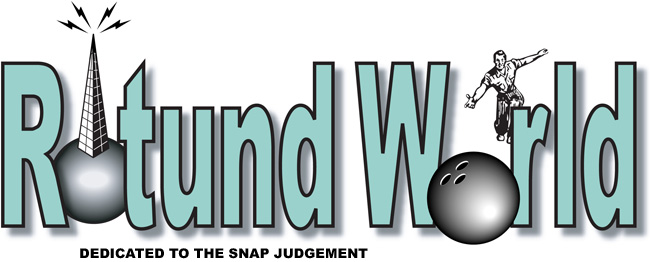
Rock Steady
Estados sensibles, the new installation by Ada Bobonis in the project space at el Museo de Arte de Puerto Rico, is a kind of marvelous airborne contraption, though there is nothing mechanical about it and, in terms of physics, at any rate, it’s as earthbound as a house under construction. We say “marvelous” because within its strict geometry and rudimentary materials, the work is all flighty illusion, full of inversions, optical pleasures, and lyrical oppositions. One of the installation’s best tricks is that it calls to mind a number different things at once, without nearly being any one of them. At first glance the installation resembles a weirdly proportioned set of on-the-cheap bleachers, or the underpinnings of an impossibly constricted dwelling. It’s made largely of construction’s most basic material—the knotty 2x4s used as throwaway forms for footings and the hidden skeletons on which walls are hung—and it’s surrounded by a handful of the artist’s photographs of monumental scaffoldings and other makeshift, new-construction buttresses.
But there is nothing makeshift about Estados sensibles. Quite the opposite. It’s detailed to a fare-thee-well, each joint cut and fit precisely. The workmanship is so attentive, in fact—it appears that wooden pegs were used for the joinery instead of nails or screws—you might think the crew chief is an Old World puritan at heart. (The night of the opening, we talked to artist Braulio Espinosa Castillo—hardly one of those—who told us that he did the work’s carpentry.) Bobonis likes to invest her installations with smart, and deeply affecting, double meanings, or plays on common sense. Sobrecielo, her 2000 work which is part of el Museo de Arte de Puerto Rico’s permanent collection—and presently viewable just around the corner from Estados sensibles—looks like an inverted, carefully manicured hedge from an English garden, though it’s made of synthetic materials and hangs above the viewer like a heavy cloud. The new work shares with Sobrecielo this down-the-rabbithole sensation of what is up and what down, since the gallery’s gray carpeting evinces something like a limitless sky and its white ceiling serves as solid ground. But Estados sensibles is yet more disarming, calling horizontality and even balance into question.
The wooden structure at the center of the work consists of two stair-stepped sections which are mirror images of each other. An inversion appears to take place before the viewer’s eyes, down the length of a single board which both sections share. The “upright” side of the structure, from the earth-bound visitor’s point-of-view, sits upside-down on its piece of “sky”, while its identical twin “hangs” from the “ground” above. Alice anyone? Are we floating in deep space yet, far from gravity’s plausibility?
This is only the most evident illusion and the broadest part of the joke. The work’s other deceptions pop into view a bit at a time. How much like drawing the sculpture is, its play of lines overtaking its familiar volumetric solidity once you begin circling the room. Look beyond those mundane piney surfaces and into the structure’s mathematical depths: your sense of balance returns and the work’s fabulous logic becomes as satisfying as a solved jigsaw puzzle. The surfaces of the boards themselves—a sight so common we hardly acknowledge it under most circumstances—attain a kind of transcendent beauty in the order and cleanliness that Bobonis has imbued them with, their dark, sappy knots standing amidst the wood grain’s russets and beiges like rocks in a mountain stream or comets in an earth-toned Milky Way. The wood’s ordinary qualities, so transformed, provide a rich, rhythmic counterpoint to the structure’s angularity and the fussy perfection its transitional passages aspire to.
We’d like to say that the photographs add something to this remarkably variable, almost symphonic weave of effects and ideas. We would guess that they’re intended to emphasize certain themes: the beauty of the quotidian and its converse, the omnipresence of beauty in the everyday. The play of inside and out is likewise evident in the photographs’ half- made or scarcely begun places. And, of course, central to these homely panoramas are ready-made versions of one of art’s most venerable, dependable motifs, the grid. Yet the photos seem just a step too far, one last utterance in case you don’t get the point, an afterthought in what must have been an unexpectedly lengthy and surprising sequence of impulses and calculations. Something so good, why stop? But our own feeling is that there is a revelatory purity to the structure itself, a grace that extends exactly from the outer edge of its physical presence to the unseeable, perhaps unfathomable, limits of its inner workings. It would be hard to improve on the simplicity and ordinariness of the 2x4, and to outdo the sublime uses to which Bobonis has put them.
Thanks to the artist for supplying us with the images for the preceding, all of them taken by Johnny Betancourt. What Else Can You Show Me?Well, these are a few of our favorite things, shows that opened recently in San Juan and environs, and that you’re sure to catch if you act quickly. We’ll just mention a few of the dizzying array of exhibitions on at present and recommend you to the various web sites that are actually doing their jobs for the clin-dets. (Clinical details for those who might not know.) Give us a break! We just got back to town, and we’ll catch up one of these days. Promise. What a dolor de la cabeza! But what fun!
First above is, of course, the island’s King of Rococo, Antonio Martorell, outdoing even himself with a grand, grandiose, and grandiloquent display of toasted artifacts, Martorell: DF, at La Ballaja. Following the Great One, another artist from the impending geezer class, Adal Maldonado, who’s graced us with a wide-ranging look at the man and the method, Blueprints for a Nation, at La Puntilla. Next are two works by up-and-coming Antonio Ayala, whose show of graphically jazzy paintings, 30 08 07, is the latest outburst at the party palace of Viejo San Juan, Casa Candela. Finally, a most amazing enterprise from the guys and gals—we assume there are gals involved—at BlackBoxArt entitled The Lab, a play on the Trexi phenomenon, whatever that is. You can get a good idea from the two images above, the one on the left being the basic ten inches or so high blank Trexi given to each of twenty artists, and the one on the right a seriously doctored Trexi done up by none other than Nuyorican Miguel Luciano. Wow! Not only was the opening a great party, DJ and all, the outcome was impressive. We hope to give these and other shows some more or less substantial play in upcoming editions of Rotund World, but don’t hold your breath. Do what the smart folks do for gallery contact information, hours, and addresses by visiting one of the many excellent arts web sites which actually keep abreast of the whirlwind that’s the contemporary scene. These inlcude Autogiro, Repuesto, Trance Líquido, and ¿Donde Veo Arte? They’ll give you the lowdown on the up and up, or at least great photographs of the messy aftermaths. One thing we can be sure of: Do not, we repeat, do not miss new paintings from Nathan Budoff at Galería 356, Diplomacia Cotidiana, opening Friday night, September 7th, according to what we read in the otherwise odious El Nueva Día. (Don’t blame us if they’re wrong.) Galería 356 is located at César González 356, natch, the phone number is 787-282-7820, and the very good web site is accessible here. Want to give Rotund World some backtalk? Email the authors. Return with us now to Miami, part 1 and part 2. |


